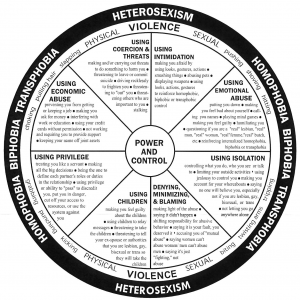|
24/7 HelpLine: 734-995-5444 If you are in immediate danger, call 911. |
Linea de Apoyo de 24 horas: 734-995-5444 Si esta en grave peligro, llame a 911. |
|
24/7 HelpLine: 734-995-5444 If you are in immediate danger, call 911. |
Linea de Apoyo de 24 horas: 734-995-5444 Si esta en grave peligro, llame a 911. |

When people are first coming out, they are very vulnerable to abuse – they may be losing friends and family or may be alienated from their cultural, ethnic, religious familial community and institutions. The isolation that most LGBT people face as a result of homophobia is useful to a batterer who is trying to isolate their partner. Threatening to “out” a person (which could mean losing children, ostracism, job loss, etc) is a powerful tool of control.
A batterer may use their own vulnerabilities to obligate or coerce their partner into staying, caring for them, and/or prioritizing batterer’s needs. Using vulnerabilities often results in survivors being exploited (resources, time attention) and undermines survivors’ attempts to negotiate boundaries or prioritize self.
In many states, LGBT people are not allowed to be the legal parent of their children. Even in states where LGBT parents’ rights are protected, not all individuals have access to the systems to assert their legal rights. For a non-biological parent, the threat of having no contact with their children makes leaving an abuse relationship a complex to impossible choice.
Using friends or family and the small number or open and affirming community spaces to monitor a survivor and gather information, or to ostracize or threaten to ostracize the survivor. Please note: safety planning cannot reply on the survivor never being in a community space with the batterer. Our communities are too small for this. We must do harm reduction planning or the survivors may “drop out” of the community to avoid the batterer and risk further isolation.
Law enforcement historically have used violence against LGBT people. LGBT people also experience discrimination and oppression based on race, class, national origin, gender, and gender identity. Many LGBT people, and particularly transgender people, have experienced discrimination within the medical system. These things are used by batterers to increase control.
LGBT people have historically been forced to make community in “illegal” and marginalized spaces such as bars. LGBT folks have higher rates of alcohol and drug use and abuse than in mainstream communities. Batterers leverage the ongoing consequences of ways that LGBT peoples’ lives have been historically criminalized as well as the realities of current drug use (and drug criminalization) when setting up/maintaining a system of power and control.
______________________________________________